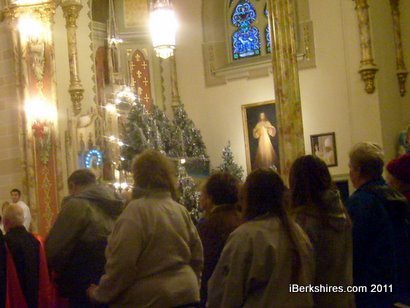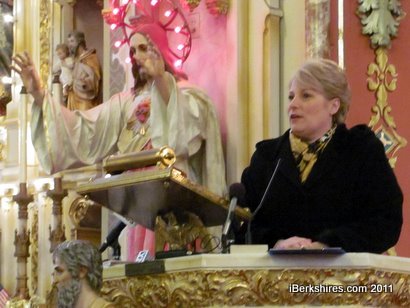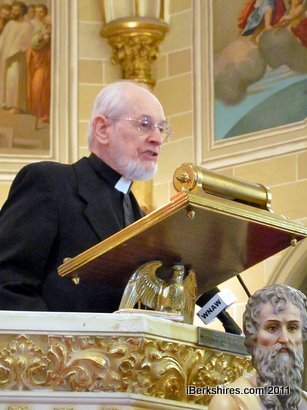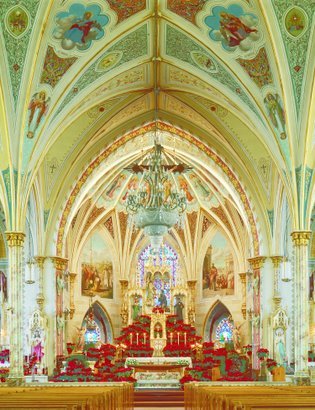| Home | About | Archives | RSS Feed |

First Western Hemisphere Divine Mercy Images Still at St. Stan's
Editor's Note: This letter about the Divine Mercy image is dated last month but resent to us today. We are posting it in full.

Published facts have now established that the first Divine Mercy Image displayed publicly anywhere in the Western Hemisphere remains at St. Stanislaus Koska Church in Adams. The Rev. Seraphim Michalenko, MIC, in a recent "Marian Helper" feature, outlines the history of the first two "just-painted" images that were placed at St. Stanislaus Koska Church and rectory in the early 1940s. At least one of them never left!
In the Winter 2010-11 Edition of the Marian Helper Magazine, in an article called "At the Epicenter for St. Faustina" by Felix Carroll, it traces the journey of Faustina's writings to the States, and decisions by the Congregation of Marians of the Immaculate Conception to place priority on spreading the Divine Mercy Message. Father Seraphim describes how he was involved in the translation of writings by Sister Faustina, a Polish nun who had died in 1938.
The Parish Church of St. Stanislaus Koska in Adams had become the first location of any Divine Mercy Image to be displayed in any church in the Western Hemisphere. There had been a painting done and displayed in a Convent in Michigan, but this was the first public location.
The Divine Mercy Devotion has had a fascinating history, and is now more relevant than ever. One can argue that Divine Providence placed St. Faustina in Poland, the Polish Catholics in Adams and Fr. Seraphim in the middle as the Divine Mercy devotion has spread. As the devotion was gaining steam, it was banned for a time as mere "private revelation." The image never left its place of honor in St. Stan's.
Pope John Paul II, then a cardinal in Poland, allowed the devotion and writings of Faustina to be more fully studied and disseminated. As Pope, he then elevated Faustina to "Blessed" and then to "Saint Faustina" in 2000, also declaring the Second Sunday of Easter as Divine Mercy Sunday that year. (This writer, former Methodist, organist at the National Shrine of The Divine Mercy in Stockbridge in 2000, converted to Catholicism, taking the confirmation name "Faustus." With Brother Ken Galisa, MIC, as my sponsor, this has been one of my greatest and most life-changing decisions. My Confirmation was at the Easter Vigil and Faustina was made St. Faustina on Divine Mercy Sunday 2000.)
All this time, from the early 1940s to now, two images have hung in St. Stan's in Adams, one in the church and one in the rectory. (The rectory image has not been confirmed as of this writing.) Presently, St. Stan's parishioners are involved in a vigil to keep the building open after it was closed as a parish, and Christmas Day 2010 will mark 730 days. This image, its presence and its meaning, can be the focus of reconciliation between the parishioners and the local diocesan bishop as no doubt many people from far and wide, learning about this, will want to come, see and venerate this image. As difficult as the church closing has been for parishioners of St. Stan's, and although they may never again be a Parish, this may be the time when this treasure moves into a larger and more universal mission, which can sustain the location as a religious, cultural and historic landmark.
St. Faustina was born in 1905 and lived to 1938. St. Stan's cornerstone was laid in 1904 and was dedicated in 1906. Adams Polish Catholics who were members of the Marians, stationed in their house in D.C., met with Polish priests who were bringing Faustina's writings about the Divine Mercy and image to the United States. New copies of the image were painted. The legend has been that the images went to Adams for safekeeping while the shrine was built in Stockbridge, where many believe the image was then enshrined. The truth is that the images never left St. Stan's.
Please take the time to read the Winter Marian Helper Magazine, Vol. 65, No. 4 for more information. Or look up the Marian website www.marian.org. Then go to Adams, and experience St. Stan's. Then, return and bring friends. It's pretty amazing. Please go soon, and spread this message to any who would be interested. The vigil in Adams has taken a lot out of the participants, and this would be a great help to them to let this fact be more widely known. Please make this your New Year's Resolution!
Suffice it to say that Christ was born into the world to save the human race. He came back and spoke to St. Faustina, during the dark days of the World Wars in Europe and asked her to spread the message of His Mercy. She faithfully recorded what he told her to record, and her writings have been published as her diary, "Divine Mercy In My Soul." She wondered how she could spread such a message worldwide, and trusted God to help her to make this happen. WE are the instruments of this mission!
This newly documented set of facts can also draw visitors to this absolutely beautiful church, described as a "gem" of the Berkshires. My opinion is that it is God's plan to use St. Stan's as the jewel box, with the DM image as its central treasure. This can also help the local economy, and give peace to all those who have worked so tirelessly to save this place. Not just the building; but the Polish Catholic legacy in Adams.
May God have mercy on all of us, and may this Divine Mercy Image of our Lord bring all souls to see a larger design that can make this one of the most treasured historic and cultural landmarks in New England.
Please take the time to support the St. Stan's vigil team and visit the first Divine Mercy Image in the Western Hemisphere. Visit, sit quietly, contemplate, and then take Christ to the World with Divine Mercy in your hearts. Sign the Guest Book "Came to See Image." But, please do it SOON!
May the spread of The Divine Mercy Message and Image be our Mission for 2011! This has been described as "one of the greatest grassroots movements in Church History." Let's make history here in Adams! Consider yourself "called."
Jeffrey William Faustus Hunt
Pittsfield
Jan. 6, 2011
St. Stan Vigilers Hope Prayers Answered

ADAMS, Mass. — St. Stanislaus Kostka Church is part of an "historic moment" in receiving one of several decrees from the Vatican so far that seem to open new avenues for closed churches.
Parishioners who have mounted a round-the-clock vigil were jubilant over the decision that rejected the Springfield Diocese's reasoning for closing the 100-year-old Polish place of worship. This, they say, means the church must be reopened as "a Catholic place of worship."
"This is a historic moment in the Catholic Church," said spokeswoman Laurie Haas after reading the letters sent to the diocese and the media and an English translation of the ruling from the Congregation of Clergy to the some 70-odd supporters seated in the pews. "We understand that a decree such as ours has only been issued in two other dioceses in the United States."
(Update: Similar decrees were sent to dioceses in Pennsylvania and Buffalo, N.Y., as well as to two other churches in the Springfield Diocese — St. George's and St. Patrick's, both in Chicopee.)
The ruling does not spell out what role the church may play in the parish — or whether the diocese can offer a better rationale to close it. "It's up to the bishop what happens next," said Haas.
"Depending on what occurs during this critical time will determine whether we go on to the next level to the Apostolic Signatura, the supreme court, which would perpetuate the whole matter," she continued. "I would hope to God the bishop does not want to do that."
Mark Dupont, spokesman for the Diocese of Springfield, said diocesan officials were reviewing the decree and had no comment at this time.
Francis Hajdas of the Friends of St. Stanislaus said the two-year vigil will continue.
"This is just a temporary thing until we get the official word," Hajdas warned the audience. "Come here at the usual time you signed up for. We'll let you know when it's all over."
The Friends have been leading a vigil that now numbers 200 participants to prevent the diocese from locking the doors and stripping the sacred relics from the Gothic church. They appealed the decision to merge the parish with nearby Notre Dame and St. Thomas and close St. Stan's, saying the Polish church was fiscally, physically and historically more suited as the parish church.
The Vatican decree, dated Jan. 25, reviews two separate issues: the suppression of the parish and its merger as the Parish of Pope John Paul the Great and the actual closing of the parish building as a house of worship.

The Congregation of Clergy upholds Bishop Timothy A. McDonnell's suppression of the parish in 2008 as part of broad consolidation of numerous parishes throughout the Western Mass. diocese.
It found some technical problems with the closing (still rejecting the appeal de procedendo, or on procedure). But, more importantly, upheld the appeal on the facts (de decernendo) that the "grave motivations" for the closing were not provided.
Haas said the group and its canonical legal advisers believe this means the church should be reopened as a place of worship in some form.
Henry "Hank " Tomkowicz described the ruling as "80 percent" good because of the ambiguity of the language, the rejection of the parish appeal and the uncertainty of the bishop's response. "Hopefully, he's with us."
The Friends hope to have dialogue with the bishop on how the church can be used. While they would prefer once again attaining the status as a parish, Haas said they would be open for use as a shrine, "if it was a shrine that wasn't 6 a.m. Mass on a Monday morning, yeah, probably."
It was important, she said, that the legacy of the church continues. The working-class Polish immigrants who laid the cornerstone and their descendants have poured money and prayer into the building, which boasts such unique features as a stained-glass window with Lenin and being the first in the Western Hemisphere to have an image of The Divine Mercy enshrined within it.
It was fitting then, that the Rev. Seraphim Michaelanko of Adams, director of the Association of Marian Helpers in Stockbridge and an expert on The Divine Mercy, arrived to lead the parishioners in prayer.
But even as they prayed, and chanted "A hundred more years" in Polish, the vigilers were prepared to stick it out to the end.
"They're ready to go on for five more years if they had to because they love this church and some things are worth fighting for," said Haas.
Vatican Decision on St. Sta... by iBerkshires.com
St. Stan's Announces Church Is Saved

ADAMS, Mass. — The vigilers of St. Stanislaus Kostka Church have been rewarded for the waiting and praying they have done for more than two years to save their church.
A decree from the Congregation of the Clergy in Rome has rejected the closing of the church.
A statement from Friends of St. Stan's spokeswoman Laurie Haas says "the Congregation's decision affirms the Diocesan decree relating to suppression and merger of St. Stan's Parish, but overturns the decree that resulted in the canonical closing of our church. As a result, St. Stan's must be reopened as a place of Catholic divine worship."
The vigilers will address the decision at 2 p.m. today at the church on the corner of Hoosac and North Summer streets.
The statement and four-page decree can be found below.
The historically Polish church was slated for closure during a sweeping consolidation of churches in the Diocese of Springfield to contend with falling attendance and increasing costs. Parishioners say they were caught off guard by the announcement because they had been under the impression St. Stan's was the most fiscally and faithfully healthy.
The day after Christmas in 2008, the Friends of St. Stan's entered the church and refused to leave. More than 200 people have participated in the round-the-clock vigil, some for an hour here or there, others spending night after night in the sanctuary through the seasons.
The group joined with churches in Boston also appealing their closure after the sex abuse scandal rocked the diocese – and led to multimillion-dollar settlements. The Boston group hasn't fared well; the Vatican rejected their pleas at the end of last year after a seven-year wait. The Boston parishes are trying a last-ditch effort to prevent the archdiocese from declaring the churches available for nonreligious use.
The Friends of St. Stanislaus have been represented by a canon advocate in Rome, who, on July 10, 2009, submitted an extensive legal brief to the Congregation of the Clergy on behalf of the parishioners summarizing the facts of the case and canon law issues: particularly the procedure followed by Bishop Timothy McDonnell, the legitimacy of the parish suppression and church closure followed within the Presbyteral Council of the Diocese of Springfield. All appeal documents can be viewed at adamscatholics.org.
The vigilers have been buoyed by recent "split" decisions of the Congregation of Clergy that seemed to indicate a diocese could consolidate parishes – but not close certain churches without grave reason. That could mean the building would remain as a site of worship, dependent upon the parishioners.
The last week may have been the hardest in the two-year wait, knowing a decision had been made by the Congregation of the Clergy in Rome and was on the way.
Vatican Decision on St. Sta... by iBerkshires.com
Pontiff Rejects Boston Parish Appeals

BOSTON — The pope has rejected the pleas of parishes in the Boston Archdiocese to remain open.
According to several media sources, a Dec. 15 letter addressed to Peter Borre, chairman of the Council of Parishes, stated, "The Holy Father [Pope Benedict XVI] was apprised of the question, which was also clearly studied by this office. ... I regret to inform you, however, that His Holiness has decided not to accept your appeal."
Borre has been the leader in the effort to keep open Boston area churches closed in 2003 as part of a consolidation sparked by financial and demographic declines. The Council of Parishes, a collaboration of 16 parishes, has been supporting vigilers trying to keep open the churches. At present, five churches are still being occupied around the clock to prevent their closure.
The decision doesn't bode well for the vigilers at St. Stanislaus Kostka in Adams, who are entering their third year in trying to keep the historic Polish church from closing.
Borre, and the Council of Parishes, have been advising the St. Stan's vigilers — as well as trailblazing the twisted path through the Vatican appeals process. The Boston group was dealt a blow last spring when the Apostolic Signatura rejected its appeals.
|
At the time, Friends of St. Stan's spokeswoman Laurie Haas, noted that the Adams parish was years behind the Boston group in the appeals process.
"We're firm and we're resolute and we set the course ...," she said then.
"Things could be very different; their outcome is not our outcome."
Borre told the Boston Herald that he received the letter from undersecretary of state Archbishop Fernando Filoni on Monday and described the final appeal directly to the pontiff as a "Hail Mary."
But while the archdiocese indicated to the Herald that the matter is closed, Borre said his group is now working on a way to keep the churches open as a place of Catholic worship.
St. Stan's Vigil to Mark Two Years

ADAMS, Mass. — The altar at St. Stanislaus Kostka Church is once again covered with a bevy of cheery red poinsettias. It's been a tradition over the years to turn the front of the sanctuary into an overflowing garden at Christmastime.
But as the Friends of St. Stan's enter their third year of protest over the historic church's closure, the setting out of the poinsettias has become a benchmark in a lengthening vigil.
Sunday will mark two years that vigilkeepers have been staying in the church in hopes of convincing the Vatican that the house of worship their grandparents and great-grandparents built a century ago will be around for their grandchildren and great-grandchildren. There is no sign of an end to the vigil as the cold creeps back into the pews.
"It's still going strong and we're entering our third winter now," said Eugene Michalenko, one of the spokesman for the vigil effort, on Thursday. "We have heard nothing yet."
St. Stan's was ordered closed as part of a consolidation in the Springfield Diocese; the parish and that of Notre Dame and St. Thomas were to be joined up the street at Notre Dame, newly renamed as Pope John Paul the Great. The use of the first Polish pope's name didn't appease some in the congregation, who immediately set up the vigil.
So for two years now, at least one person has been in the Polish church to keep the diocese from locking the doors. The vigilers will hold a small celebration and sing Christmas carols at 1 p.m. on the anniversary.
Volunteers are there round the clock, taking turns and even sleeping in the cold church. This year, a space heater warms a small room behind the altar to give the faithful some respite.
The group is waiting on a decision from the Vatican that could take years. Parishioners joined eight other churches in the state in appealing their closures to the Apostolic Signatory but that decision has been delayed multiple times. The Signatory is the last step in the appeals process.

The building is no longer a church in the eyes of the Springfield Diocese and Mass is not held there, but parishioners do still pray there.
If St. Stan's is empty, church officials will lock the doors and strip the interior of religious relics before it sells the building.
Vigilers fear their Polish heritage will be stripped along with icons and stained glass.
In Boston, vigils continue in a handful of churches; in other parts of the country, vigil attempts have been cut short by police action. The Friends of St. Stan's were concerned about that at first but an uneasy truce with the diocese has left both playing a waiting game.
The massive chandeliers, the painted ceiling and all the decorations and architecture has created one of the most beautiful churches in the county. Vigilkeepers say it's priceless and by staying in the building, the church will remain intact.
And so the annual tradition of decorating the altar still continues, but change is inevitable. Zepka J & Sons Florists used to bring thousands of flowers into the church every winter but this year it had to be scaled back, Michalenko said.
The 100-year-old florist closed this fall; owner Matthew Zepka, a longtime usher and Eucharistic minister at St. Stan's, died last December at the age of 89.
Thomas Zepka, his son, used his connections with wholesalers to bring in about 60 red poinsettias this year.
"Now people are buying them individually and bringing them in," Michalenko said. "It's not as big as it used to be. The alter used to be full."


 10 days of a decree of suppres-
10 days of a decree of suppres-
 appeal to the Apostolic Signatory, the Vatican's "supreme court." It is headed by St. Louis' former Archbishop Raymond Burke, who leans conservative.
appeal to the Apostolic Signatory, the Vatican's "supreme court." It is headed by St. Louis' former Archbishop Raymond Burke, who leans conservative.